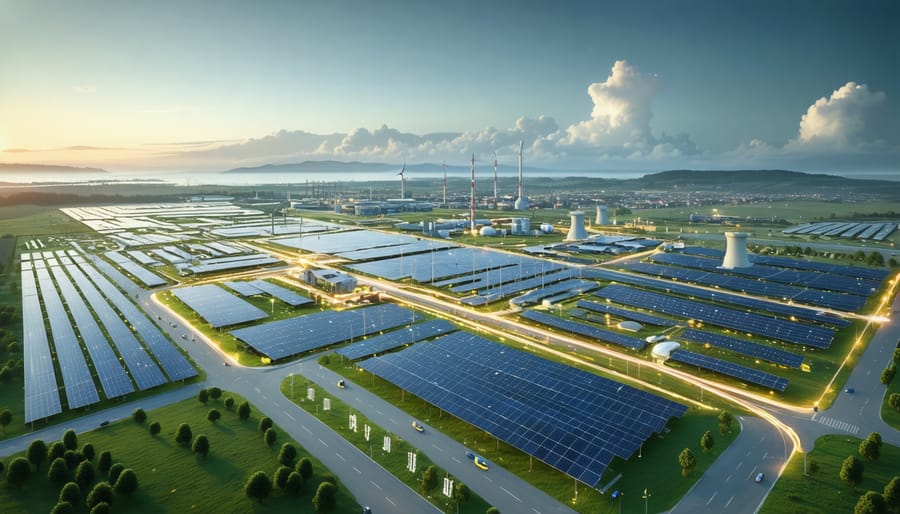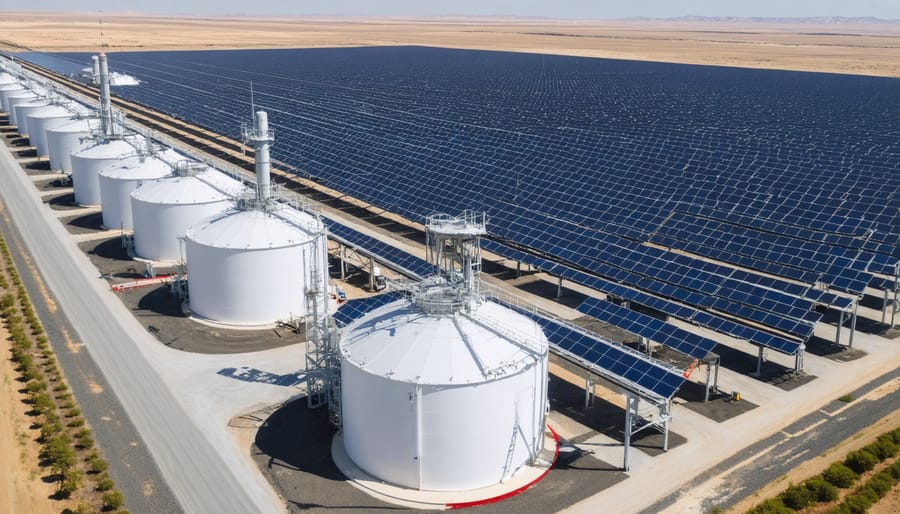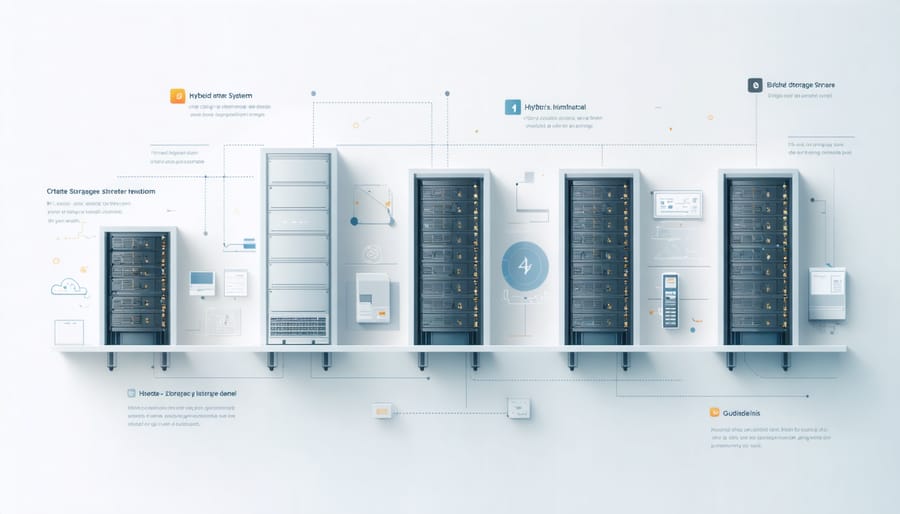These Advanced Storage Technologies Are Revolutionizing Solar Energy

Advanced storage technologies are revolutionizing how Europe harnesses and deploys renewable energy, with solar energy storage systems leading this transformation. From grid-scale batteries to innovative thermal solutions, these technologies are rapidly evolving to meet the growing demands of a sustainable energy future. The integration of smart storage solutions has become crucial for maintaining grid stability, reducing energy costs, and ensuring consistent power supply across residential and industrial applications.
As we witness unprecedented growth in renewable energy adoption, storage technologies have emerged as the critical link between intermittent generation and reliable power delivery. Modern storage solutions now offer multiple value streams – from peak shaving and demand response to emergency backup and grid services. This convergence of advanced storage capabilities with intelligent energy management systems is creating new opportunities for businesses and homeowners to optimize their energy consumption while contributing to Europe’s clean energy transition.
The latest developments in storage technology combine high-density energy storage materials, sophisticated battery management systems, and artificial intelligence to deliver unprecedented levels of efficiency and reliability. These innovations are making it possible to store and deploy clean energy at scales previously thought impractical, fundamentally changing how we think about energy security and sustainability.
Next-Generation Battery Technologies
Solid-State Batteries
Among next-generation battery technologies, solid-state batteries represent a significant leap forward in energy storage innovation. Unlike traditional lithium-ion batteries that use liquid electrolytes, solid-state batteries employ solid electrolyte materials, offering enhanced safety and performance characteristics that make them particularly attractive for solar energy storage applications.
The key advantage of solid-state batteries lies in their improved energy density, potentially storing up to three times more energy than conventional batteries while maintaining a compact form factor. This higher energy density translates to more efficient storage solutions for solar power systems, enabling homeowners and businesses to maximize their renewable energy utilization.
Safety is another crucial benefit, as solid-state batteries eliminate the risk of electrolyte leakage and are significantly less prone to thermal runaway issues. This makes them ideal for residential installations where safety is paramount. Additionally, these batteries demonstrate superior longevity, with some prototypes showing minimal capacity degradation even after thousands of charging cycles.
European manufacturers are at the forefront of solid-state battery development, with several pilot projects already demonstrating promising results. While currently in the early stages of commercialization, the technology is expected to become more accessible and cost-effective within the next few years, potentially revolutionizing how we store solar energy in both residential and commercial applications.

Flow Batteries
Flow batteries represent a promising innovation in energy storage technology, particularly for large-scale solar installations. Unlike traditional batteries, these systems store energy in liquid electrolytes housed in separate tanks, offering unique advantages for renewable energy applications.
The fundamental principle behind flow batteries is remarkably straightforward: two liquid electrolytes circulate through an electrochemical cell where the energy conversion takes place. This design allows for independent scaling of power and energy capacity – the cell size determines the power output, while the tank volume dictates storage capacity.
For European businesses and industrial facilities, flow batteries offer several compelling benefits. Their long cycle life, typically 20+ years, makes them particularly cost-effective for large-scale applications. They can operate at room temperature without degradation, require minimal maintenance, and can be fully discharged without damage – characteristics that traditional lithium-ion batteries cannot match.
Vanadium redox flow batteries (VRFB) are currently the most commercially advanced variation, with several successful installations across Europe. These systems demonstrate remarkable efficiency, maintaining up to 85% round-trip efficiency in optimal conditions. Moreover, the electrolyte can be fully recycled at the end of the system’s life, aligning with European sustainability goals.
While initial installation costs remain higher than some alternatives, flow batteries excel in applications requiring long-duration storage (4+ hours) and frequent cycling. They’re particularly valuable for industrial solar installations, grid stabilisation, and renewable energy integration projects where reliability and longevity are paramount considerations.
Thermal Energy Storage Systems

Molten Salt Storage
Molten salt storage represents one of the most promising thermal energy storage solutions in modern solar installations. This innovative technology uses specially formulated salt mixtures that can maintain temperatures between 290°C and 565°C, making them ideal for storing large amounts of thermal energy from solar power plants.
The process involves heating the salt mixture during peak sunlight hours, storing it in well-insulated tanks, and then using this stored heat to generate electricity when needed, even after sunset. This capability effectively bridges the gap between energy production and demand, allowing solar facilities to operate around the clock.
Several European solar projects have successfully implemented molten salt storage systems. Spain’s Gemasolar plant, for instance, achieves up to 15 hours of energy storage, enabling continuous power generation throughout the night. The technology’s efficiency rates typically range between 80-90%, significantly higher than many alternative storage methods.
For industrial applications, molten salt storage systems offer particular advantages in regions with high solar irradiance. The technology’s scalability makes it suitable for both large utility-scale projects and medium-sized industrial installations, though the initial investment costs remain a consideration for smaller operations.
Recent innovations in salt compositions and tank designs have further improved the technology’s reliability and reduced maintenance requirements, making it increasingly attractive for new solar installations across Europe.
Phase Change Materials
Phase Change Materials (PCMs) represent an innovative approach to thermal energy storage in solar applications. These sophisticated materials can absorb, store, and release large amounts of energy during phase transitions, typically between solid and liquid states, while maintaining a nearly constant temperature.
In solar energy systems, PCMs are particularly valuable for their ability to capture excess heat during peak production hours and release it when needed, effectively bridging the gap between energy availability and demand. Common materials include paraffin waxes, salt hydrates, and fatty acids, each offering specific advantages for different applications.
For European homeowners and businesses, PCM integration in solar thermal systems can significantly enhance energy efficiency. When incorporated into building materials or dedicated storage units, PCMs can help regulate indoor temperatures, reducing heating and cooling costs by up to 30%. This technology is especially effective in regions with substantial temperature variations between day and night.
Industrial applications of PCMs in solar storage systems are equally promising. Large-scale installations can use these materials to maintain consistent process temperatures or provide reliable heat supply for manufacturing operations. Recent innovations in PCM encapsulation and containment have improved their long-term stability and heat transfer efficiency, making them increasingly attractive for commercial deployments.
The technology continues to evolve, with researchers developing new PCM compositions that offer higher energy density and improved thermal conductivity, promising even greater energy storage capabilities for future solar applications.

Hybrid Storage Solutions
Battery-Thermal Combinations
Battery-thermal hybrid systems represent one of the most promising developments in energy storage technology, combining the rapid response of batteries with the cost-effectiveness of thermal storage solutions. These innovative systems can efficiently manage both electrical and heating demands, making them particularly valuable for European climates where seasonal variations affect energy needs significantly.
The integration works by using batteries to handle immediate electrical demands and peak shaving, while thermal storage components store excess energy as heat for space heating, domestic hot water, or industrial processes. This dual-purpose approach maximises overall system efficiency and reduces energy waste.
In practice, these hybrid systems can achieve remarkable results. For instance, commercial installations in Northern Europe have demonstrated energy cost reductions of up to 30% compared to single-storage solutions. The flexibility of these systems allows businesses to optimise their energy consumption patterns, storing excess solar energy as either electricity or heat depending on current and anticipated needs.
The technology is particularly beneficial for industries with both high electrical and thermal demands, such as food processing facilities and hotels. For homeowners, battery-thermal combinations can provide comprehensive energy management, ensuring year-round comfort while minimising grid dependency.
Smart Grid Integration
Advanced storage technologies play a crucial role in smart grid integration, enabling a more resilient and efficient power distribution system. These sophisticated storage solutions act as the backbone of modern electrical networks, helping balance supply and demand while maintaining grid stability.
By incorporating intelligent communication systems, advanced storage facilities can respond instantly to grid requirements, storing excess energy during peak production periods and releasing it when demand surges. This bidirectional flow of energy and data enables grid operators to optimize power distribution across different regions and time zones.
For European businesses and homeowners, this integration means more reliable power supply and better utilization of renewable energy sources. Storage systems can automatically adjust their charging and discharging patterns based on real-time grid conditions, energy prices, and weather forecasts. This smart functionality helps reduce energy costs while contributing to grid stability.
The system’s ability to provide ancillary services such as frequency regulation and voltage support makes it an invaluable component of modern power infrastructure. As Europe continues its transition toward renewable energy, these advanced storage solutions ensure seamless power delivery while maintaining the highest standards of grid reliability and efficiency.
Future-Ready Storage Technologies
Hydrogen Storage Systems
Hydrogen storage systems represent an innovative frontier in long-term solar energy storage, offering a sustainable solution for periods when solar generation exceeds immediate demand. This technology converts surplus solar electricity into hydrogen through electrolysis, effectively storing energy in chemical form for extended periods.
The process begins when excess solar power drives an electrolyser, splitting water into hydrogen and oxygen. The hydrogen can then be stored in specialized tanks under pressure or in advanced material-based storage systems. When energy is needed, the stored hydrogen powers fuel cells to generate electricity, completing a clean energy cycle with water as the only byproduct.
For European businesses and homeowners, hydrogen storage systems offer distinct advantages, particularly in regions with seasonal variations in solar production. These systems can store energy for weeks or even months, providing reliable backup power during winter months when solar generation is typically lower.
Recent innovations in storage technology have improved system efficiency and reduced costs, making hydrogen storage increasingly viable for large-scale applications. Several pilot projects across Europe demonstrate successful integration of hydrogen storage with solar installations, particularly in industrial settings and community-scale energy projects.
While currently more suitable for industrial applications and large-scale energy storage, ongoing technological developments are gradually making hydrogen storage more accessible for smaller commercial installations and eventually residential applications.
Compressed Air Storage
Compressed air energy storage (CAES) represents one of the most innovative large-scale energy storage solutions available today. This technology harnesses excess electricity to compress air, which is then stored in underground caverns or specially designed tanks. When energy is needed, the compressed air is released and heated, driving turbines to generate electricity.
The technology has gained significant traction in Europe, with notable installations in Germany demonstrating its viability for grid-scale storage. The Huntorf plant in Germany, operational since 1978, remains a testament to the reliability of CAES systems, providing crucial backup power during peak demand periods.
Modern CAES systems achieve efficiency rates of up to 70% when integrated with advanced thermal management systems. This makes them particularly attractive for industrial applications and renewable energy integration, where large-scale storage is essential for managing intermittent power sources.
For European businesses and utilities, CAES offers several advantages: long operational lifetime (40+ years), minimal environmental impact, and the ability to provide both short-term and long-term storage solutions. The technology excels in applications requiring multiple daily cycles and can be scaled according to specific energy storage needs.
Recent innovations in adiabatic CAES systems, which capture and reuse the heat generated during compression, promise even greater efficiency improvements, making this technology increasingly relevant for sustainable energy future.
Advanced storage technologies have revolutionized the solar energy landscape across Europe, making renewable energy more accessible and practical than ever before. The integration of sophisticated storage solutions has effectively addressed the intermittency challenges that once limited solar power adoption, enabling consistent energy supply regardless of weather conditions or time of day.
The impact of these technologies extends far beyond individual households. Businesses are experiencing enhanced energy independence and significant cost reductions, while industrial facilities are successfully managing their peak demand through strategic energy storage deployment. The combination of solar panels with modern storage systems has created a robust foundation for Europe’s clean energy transition.
Looking ahead, the continued evolution of storage technologies promises even greater benefits. Improved battery lifespans, reduced costs, and enhanced efficiency are making solar energy systems increasingly attractive to property owners. This technological progress, coupled with supportive EU policies and growing environmental awareness, is accelerating the shift toward sustainable energy solutions.
The role of advanced storage technologies in driving solar adoption cannot be overstated. They have transformed solar power from an intermittent energy source into a reliable, round-the-clock power solution. As these technologies continue to mature and become more affordable, they will remain crucial in achieving Europe’s ambitious renewable energy goals and supporting the continent’s commitment to carbon neutrality.
Leave a Reply